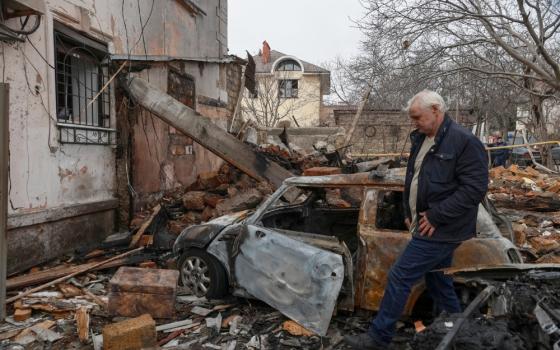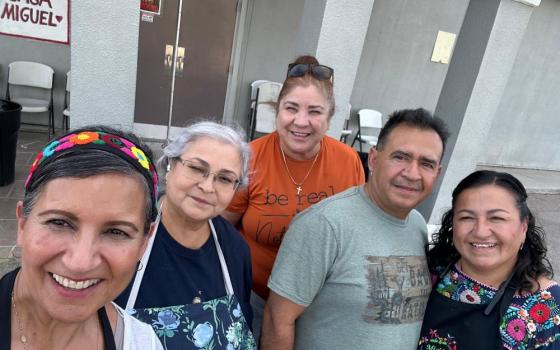
LIMA, PERU -- High in the Andes Mountains, Peruvian Good Shepherd Sr. Olga Soldevilla trudges up a hill to meet with Quechua-speaking women who are organizing to knit handcrafts in hopes of earning enough money to keep their children from drifting toward the mining camps and brothels across the mountains, down a newly paved highway.
In Palenque, Mexico, Brazilian Sr. Malgarete Scapinelli Conte pauses outside the parish gate to speak with a teenage boy from Honduras who is seeking food and shelter. He is one of hundreds of migrants who pass through the town every week, hitching a ride on a northbound freight train.
In the steamy Amazonian lowlands of northern Brazil, ranchers and loggers threaten small landholders who have migrated to the area in search of land to farm. They gather under a thatch-roofed shelter to discuss their problems, just a few yards from the grave of Notre Dame Sr. Dorothy Stang, who was murdered by a hired gunman in 2005 because of her efforts to organize and defend the small farmers.
In Latin America, as the civil wars of the 1970s and 1980s gave way to the globalized economy of the 1990s and early 21st century, religious women responded to the changes by moving into new ministries, challenging both society and the church.
“When you talk about religious life, you can’t talk about one block,” said Brazilian theologian Ivone Gebara, a member of the Sisters of Our Lady (Canoneses of St. Augustine). “You have to talk about diversity.”
Religious life in the region evolved over the past half-century. The “option for the poor,” which galvanized the Latin American church after the conferences of bishops in Puebla, Mexico, in 1979 and Medellín, Colombia, in 1968, changed the way religious communities approached their ministries.
“It was very much a female phenomenon -- of not just talking or writing about the option for the poor, but of going to live closer to the people who suffer,” Gebara said. Of the “hundreds or thousands” of communities that moved out into shantytowns and villages, “very few were male.”
Sisters shared their neighbors’ struggles for justice, as well as the hardships that came with a lack of water and electricity, providing social services, helping them organize, teaching them to read and write, walking with them, praying with them and -- perhaps most importantly -- striving to empower them.
Many lived and worked in parishes that sprang up around the edges of cities such as São Paulo, Brazil, or Lima, Peru, which doubled in size as people moved from the countryside to urban areas in search of better opportunities for their families. Moving to the shantytowns and choosing a communal lifestyle made sense in the context of those times, Gebara said, but she added, “This is a different moment.”
The civil wars, dictatorships and rebellions are past, although scars linger in many places. In most countries, poverty rates are falling and health care and education are improving, although there is still far to go and the income gap remains wide. And in what is still nominally the world’s most Catholic continent, many people do not go to Mass or participate in parish life.
Meanwhile, the winds of change that blew through the region in the wake of the Second Vatican Council (1962-65) have died down. The progressive bishops of those years have retired or died, and the institutional church is becoming more centralized and authoritarian, Gebara said.
In response, many sisters have moved out of parishes into other realms of society, pursuing individual works in church or civic organizations on issues ranging from human rights to climate change.
“We shouldn’t think religious life must follow traditional models, or that we aren’t marked by the individualism of modern society,” Gebara said of what she sees as a trend toward more individualistic ministries.
Nevertheless, Mercy Sr. Patricia Mulderick believes that community life still provides an alternative to individualism, and it was that life that drew Mercy Sr. Blanca Quintana to the group, even though she was in her late 30s and had a career as a psychologist.
The sisters’ work has evolved, however.
“I believe religious life is called to insert itself into other spaces,” such as politics, where sisters can work to change unjust structures, Quintana said. That may mean working with groups that have not traditionally been part of the church, such as homosexuals or gang members, “where we can also see the face of God,” she said.
Religious life may also become more ecumenical and inclusive of laypeople, she said. “It invites is to break out of old models and be creative, not just to be comfortable in our old ways.”
For Daughter of the Holy Spirit Sr. Rosa María Moreno, assistant secretary general of the Latin American and Caribbean Confederation of Religious, the challenges have led religious communities to “create new faces of consecrated life that are open to new opportunities. New faces need new attitudes -- of listening, discernment, compassion, seeking.”
Those “new faces,” Moreno said, imply new arenas for pastoral work, such as urban ministry in the region’s megacities.
“Few people go to church,” she said. “People congregate in plazas and other places. We are the church. Instead of expecting people to come to the church building, we need to go to the people” in other places, such as universities.
Religious women are also responding to the threats posed by climate change and environmental damage, working with rural communities that are fighting for land or water rights and engaging in advocacy on climate change.
Increased awareness of the region’s most marginalized groups has given rise to work with Afro-Latin American communities and indigenous communities, which remain the poorest and most disenfranchised in Latin America despite the region’s growing wealth.
The Sisters of St. Francis of Penance and Christian Charity in Palenque, Mexico, focus on ministry with women -- particularly indigenous women in Mayan communities, where opportunities for education, especially for girls, are still limited.
“Here people say that women suffer quadruple discrimination -- because they’re women, because they’re indigenous, because they’re poor and because they don’t know how to read and write,” said Sr. María Elena Rodríguez, one of the founders of the Palenque mission.
The community now includes American and Mexican women, both indigenous and mestiza, or mixed-race, reflecting a growing trend toward international, multicultural religious communities.
When Sr. Cándida González joined the community, she found herself questioning the stereotypes about indigenous Mexicans that she had heard all her life. She was impressed by the self-confidence and leadership skills of the young indigenous sisters, and was a little envious that they all spoke a native language as well as Spanish.
She has learned to understand and appreciate their customs -- such as the “planting” of a wooden cross in the field behind the sisters’ house, to ensure a good harvest -- and has been invited to participate in indigenous rituals led by community elders, a sign that they trust and accept her.
Like the Franciscans in Palenque, the Mercy Sisters’ community in Lima is also a cultural mix. The sisters have opened their doors to associates -- local laypeople who feel drawn to their charism, but not to religious life. Moreno said many congregations are looking for ways to work more closely with laypeople.
“Groups of associates are different, depending on the congregation,” Gebara said. Some people are drawn by a religious community’s prayer life, while others participate directly in their work.
“I don’t believe associates will be the re-founding of the congregation,” Gebara said of her congregation, which has two such groups. “I don’t see that they are very independent of the sisters. I don’t think they will give the congregation a new configuration.”
Meanwhile, aging, attrition and a shortage of vocations are taking their toll on numbers in religious communities throughout Latin America. “It’s the life cycle of religious life and everyone’s life,” Moreno said.
Ultimately, Gebara believes that the next generations will find new ways to carry on the legacy left by the religious women who came before them.
“I don’t worry too much about how religious life will be. I think it’s more important to ask how Christian life will be; that is the challenge. The institutional church does not recognize that there are important new challenges that require a different response,” she said. “I believe the task now is to share the richness, knowledge and wisdom that we have acquired, and let the next generations be inspired and discover the paths by which they can live out love, justice and the common good.”
[Barbara Fraser is a freelance journalist based in Lima, Peru.]




